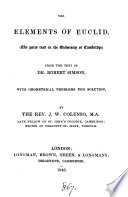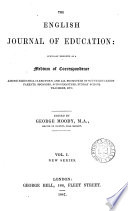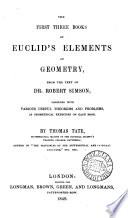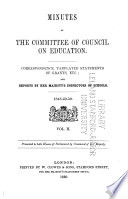 | Euclid, John Playfair - 1846 - 334 sider
...equal to the square of the other part. Let AB be the given straight line ; it is required to divide it into two parts, so that the rectangle contained by the whole, and one of the parts, shall be equal to the square of the other part. Upon AB describe (46. 1.) the square ABDC ; bisect... | |
 | Euclides - 1846 - 292 sider
...equal to the square of the other part. Let AB be the given straight line : it is required to divide it into two parts, so that the rectangle contained by the whole and one of the parts shall be equal to the square of the other part. Upon AB describe the square ACDB ; bisect AC in E,... | |
 | Great Britain. Committee on Education - 1847 - 606 sider
...the angle contained by these two sides is a right angle. SECTION II. 1. To divide a straight line, so that the rectangle contained by the whole and one of the parts shall be equal to the square of the other part. 2. In every triangle the square of the side subtending... | |
 | 1847 - 508 sider
...angle contained by these two sides is a light angle. SECTION Il. — 1. To divide a straight line, so that the rectangle contained by the whole and one of the parts shall be equal to the square of the other part. 2. In every triangle the square of the side subtending... | |
 | J. Goodall, W. Hammond - 1848 - 390 sider
...intercepted without the triangle between the perpendicular and the obtuse angle. Section 4. 1. Divide a given straight line into two parts, so that the rectangle contained by the whole and one of the parts shall be equal to the square of the other part. 2. Describe a square that shall be double a given triangle.... | |
 | Euclides - 1848 - 52 sider
...square of the line made up of the half and the part produced. PROP. XI. PROBLEM. To divide a given straight line into two parts, so that the rectangle contained by the whole and one of the parts, shall be equal to the square of the other part. PROP. XII. THEOREM. In obtuse-angled triangles, if... | |
 | Euclid, Thomas Tate - 1849 - 120 sider
...Wherefore, if a straight line, &c. QED Again, because EG F is EF PROP. XI. PROB. To divide a given straight line into two parts, so that the -rectangle contained by the whole, and one of the parts, shall Tie equal to the square of the other part. Let AB be the given straight line; it is required... | |
 | University of Cambridge - 1849 - 560 sider
...homogeneity of algebraical equations, or any demonstration other than Euclid's ? 3. Divide a given straight line into two parts, so that the rectangle contained by the whole and one of the parts shall be equal to the square of the other part. Shew that in Euclid's figure four other lines, beside... | |
 | Great Britain. Committee on Education - 1850 - 942 sider
...between the same parallels, are equal to one another. 3. Solve Euc. II. 11. To divide a given finite straight line into two parts, so that the rectangle...the whole and one of the parts may be equal to the squire of the other part. 4. Prove Euc. III. 22. The opposite angles of any quadrilateral figure inscribed... | |
 | Her MAjesty' Inspectors of schools - 1850 - 912 sider
...figures, and duplicate ratio. 3. Solve Euc. II. 11. To divide a given finite straight line into two part*, so that the rectangle contained by the whole and one of the parts may be equal to the square of the other jjart. '2. Prove Kuc. 1. 36. Parallelograms upon equal bases, and between the same parallels,... | |
| |